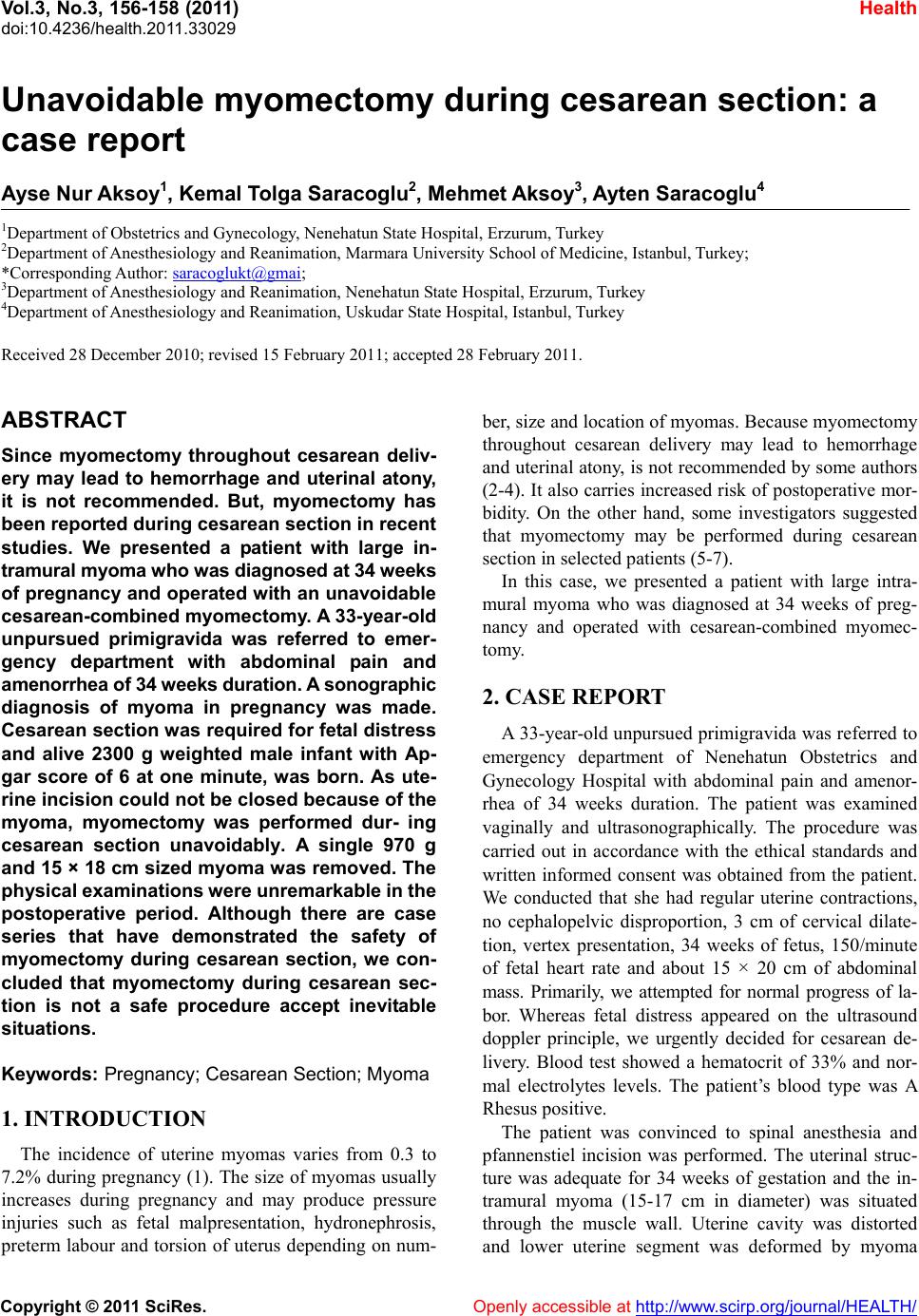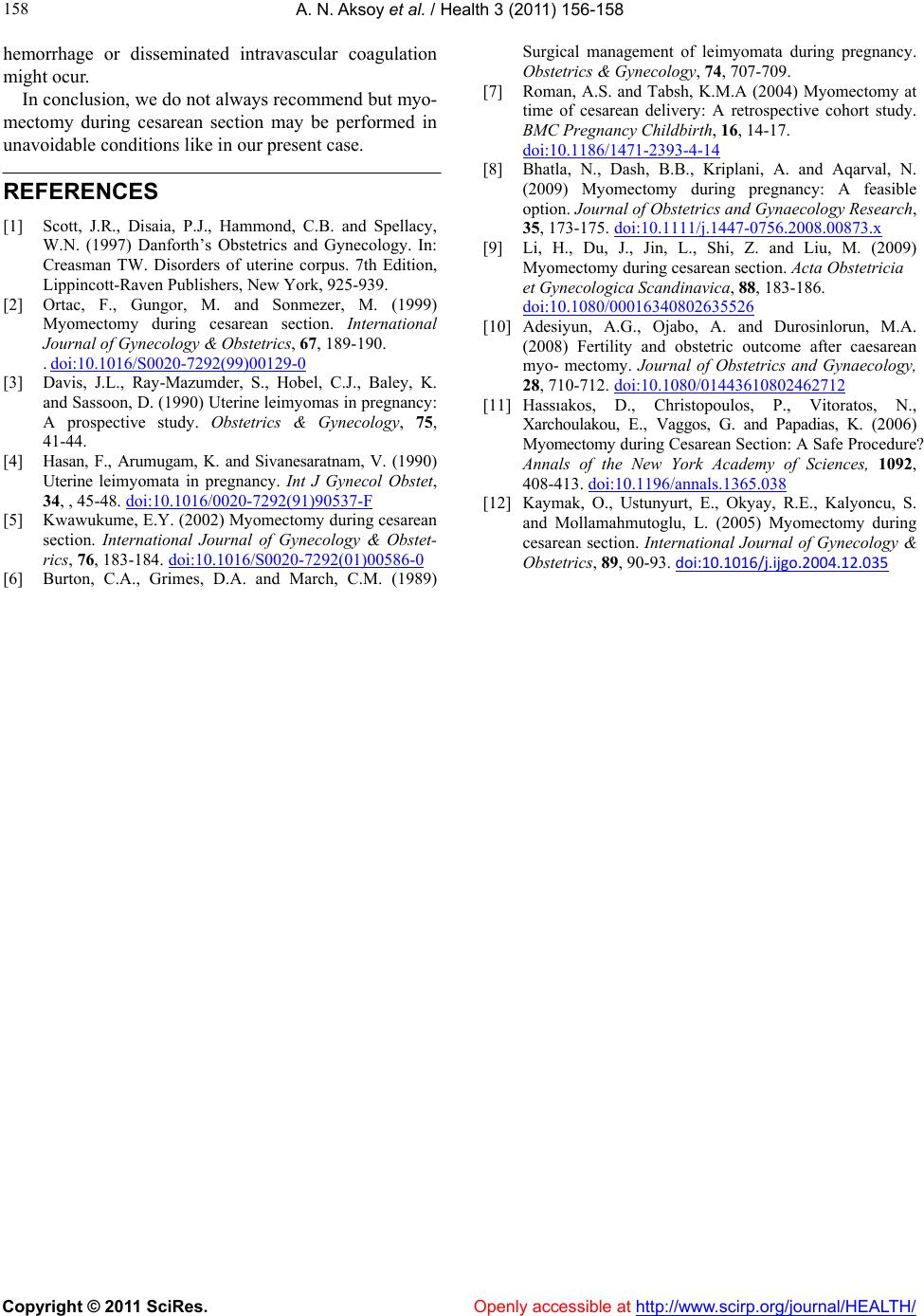Paper Menu >>
Journal Menu >>
 Vol.3, No.3, 156-158 (2011) Health doi:10.4236/health.2011.33029 Copyright © 2011 SciRes. Openly accessible at http://www.scirp.org/journal/HEALTH/ Unavoidable myomectomy during cesarean section: a case report Ayse Nur Aksoy1, Kemal Tolga Saracoglu2, Mehmet Aksoy3, A yten Saracoglu4 1Department of Obstetrics and Gynecology, Nenehatun State Hospital, Erzurum, Turkey 2Department of Anesthesiology and Reanimation, Marmara University School of Medicine, Istanbul, Turkey; *Corresponding Author: saracoglukt@gmai; 3Department of Anesthesiology and Reanimation, Nenehatun State Hospital, Erzurum, Turkey 4Department of Anesthesiology and Reanimation, Uskudar State Hospital, Istanbul, Turkey Received 28 December 2010; revised 15 February 2011; accepted 28 February 2011. ABSTRACT Since myomectomy throughout cesarean deliv- ery may lead to hemorrhage and uterinal atony, it is not recommended. But, myomectomy has been reported during cesarean section in recen t studies. We presented a patient with large in- tramural myoma who was diagnosed at 34 weeks of pregnancy and operated w ith an unavoidable cesarean-com bi ned myomectomy. A 33-year-old unpursued primigravida was referred to emer- gency department with abdominal pain and amenorrhea of 34 weeks duration. A sonographic diagnosis of myoma in pregnancy was made. Cesare an sect ion was r equire d for f etal distress and alive 2300 g weighted male infant with Ap- gar score of 6 at one minute, was born. As ute- rine incision could not be closed because of the myoma, myomectomy was performed dur- ing cesarean section unavoidably. A single 970 g and 15 × 18 cm sized myoma was removed. The physical examinations were unremarkable in the postoperative period. Although there are case series that have demonstrated the safety of myomectomy during cesarean section, we con- cluded that myomectomy during cesarean sec- tion is not a safe procedure accept inevitable situations. Keywords: Pregnancy; Cesarean Sectio n; Myoma 1. INTRODUCTION The incidence of uterine myomas varies from 0.3 to 7.2% during pregnancy (1). The size of myomas usually increases during pregnancy and may produce pressure injuries such as fetal malpresentation, hydronephrosis, preterm labour and torsion of uterus depending on num- ber, size and location of myomas. Because myomectomy throughout cesarean delivery may lead to hemorrhage and uterinal atony, is not recommended by some authors (2-4). It also carries increased risk of postoperative mor- bidity. On the other hand, some investigators suggested that myomectomy may be performed during cesarean section in selected patients (5-7). In this case, we presented a patient with large intra- mural myoma who was diagnosed at 34 weeks of preg- nancy and operated with cesarean-combined myomec- tomy. 2. CASE REPORT A 33-year-old unpursued primigravida was referred to emergency department of Nenehatun Obstetrics and Gynecology Hospital with abdominal pain and amenor- rhea of 34 weeks duration. The patient was examined vaginally and ultrasonographically. The procedure was carried out in accordance with the ethical standards and written informed consent was obtained from the patient. We conducted that she had regular uterine contractions, no cephalopelvic disproportion, 3 cm of cervical dilate- tion, vertex presentation, 34 weeks of fetus, 150/minute of fetal heart rate and about 15 × 20 cm of abdominal mass. Primarily, we attempted for normal progress of la- bor. Whereas fetal distress appeared on the ultrasound doppler principle, we urgently decided for cesarean de- livery. Blood test showed a hematocrit of 33% and nor- mal electrolytes levels. The patient’s blood type was A Rhesus positive. The patient was convinced to spinal anesthesia and pfannenstiel incision was performed. The uterinal struc- ture was adequate for 34 weeks of gestation and the in- tramural myoma (15-17 cm in diameter) was situated through the muscle wall. Uterine cavity was distorted and lower uterine segment was deformed by myoma  A. N. Aksoy et al. / Health 3 (2011) 156-1 58 Copyright © 2011 SciRes. Openly accessible at http://www.scirp.org/journal/HEALTH/ 157 partially. A vertical uterine incision was made and alive male infant with Apgar score of 6 at one minute and 2300 g weighted was born. Uterine incision could not be closed because of the myoma. Then, the myometrium overlying the myoma was incised and pseudocapsule was dissected (Figure 1) by using electro-cautery to re- duce blood loss. A single myoma measuring 15 × 18 cm sized, 970 g weighted was removed (Figure 2). Hemo- stasis was achieved by 1-0 and 0 vicryl sutures (Figure 3). The serosa was sutured using absorbable suture (2-0 or 3-0 vicryl). Prophylactic an tibiotics wer e used and th e patient received antibiotics for seven days post-operatively. Approximately 700 ml of blood loss was replaced by colloids without blood transfusion. The operation took place in 1.5 hours time. Intra-abdominal drain of hemovac was placed without vacuum. The postoperative hema- tocrit value was 30% and there were no maternal or fetal complications. The patient was discharged from the hos- pital at 8th postoperative day. The physical examinations Figure 1. Dissection of the pseudocapsule and removing the myoma. Figure 2. The appearance of myoma after removal. Figure 3. Final appearance after myomectomy. were unremarkable in the four weeks period after hospi- talisation. 3. DISCUSSION Myomectomy is rarely performed during an ongoing pregnancy because of the risk of uncontrolled hemor- rhage necessitating hysterectomy. In recent studies, Bhatla et al. (8) performed successful myomectomy in the second trimester for a large subserous fibroid, weigh- ing 3900 g. Then the pregnancy continued uneventfully until term. Li H et al. (9) arised that mymectomy during cesarean section was a safe and effective procedure. Adesiyun et al. (10) investigated the fertility perform- ance and pregnancy outcome in pregnants who had ce- sarean myomectomy at last delivery. They noticed no maternal or perinatal mortality factors. They suggested that the future fertility and or subsequent pregnancy outcome in patients were not affected by cesarean myo- mectomy. Hassiakos et al. (11) previously investigated the si- multaneous surgical removal of myoma diagnosed dur- ing cesarean section and they recommended that this procedure may be applied during cesarean section. Kaymak et al. (12) compared myomectomy during ce- sarean section with myomas and underwent alone. They found no significant diferences in the incidence of post- operative fever, hemorrhage and frequency of blood transfusion between myomectomy and control groups. They concluded that myomectomy can be performed without significant complications by experienced obste- tricians during the cesarean section. In our case, we per- formed unavoidable myomectomy in cesarean surgery without blood transfusion and maternal complication. Because the reclosure of the abdomen was impossible, we performed mymectomy without any complication. However, possible life threatening complications such as  A. N. Aksoy et al. / Health 3 (2011) 156-1 58 Copyright © 2011 SciRes. Openly accessible at http://www.scirp.org/journal/HEALTH/ 158 hemorrhage or disseminated intravascular coagulation might ocur. In conclusion, we do not always recommend but myo- mectomy during cesarean section may be performed in unavoidable conditions like in our present case. REFERENCES [1] Scott, J.R., Disaia, P.J., Hammond, C.B. and Spellacy, W.N. (1997) Danforth’s Obstetrics and Gynecology. In: Creasman TW. Disorders of uterine corpus. 7th Edition, Lippincott-Raven Publishers, New York, 925-939. [2] Ortac, F., Gungor, M. and Sonmezer, M. (1999) Myomectomy during cesarean section. International Journal of Gynecology & Obstetrics, 67, 189-190. . doi:10.1016/S0020-7292(99)00129-0 [3] Davis, J.L., Ray-Mazumder, S., Hobel, C.J., Baley, K. and Sassoon, D. (1990) Uterine leimyomas in pregnancy: A prospective study. Obstetrics & Gynecology, 75, 41-44. [4] Hasan, F., Arumugam, K. and Sivanesaratnam, V. (1990) Uterine leimyomata in pregnancy. Int J Gynecol Obstet, 34, , 45-48. doi:10.1016/0020-7292(91)90537-F [5] Kwawukume, E.Y. (2002) Myomectomy during cesarean section. International Journal of Gynecology & Obstet- rics, 76, 183-184. doi:10.1016/S0020-7292(01)00586-0 [6] Burton, C.A., Grimes, D.A. and March, C.M. (1989) Surgical management of leimyomata during pregnancy. Obstetrics & Gynecology, 74, 707-709. [7] Roman, A.S. and Tabsh, K.M.A (2004) Myomectomy at time of cesarean delivery: A retrospective cohort study. BMC Pregnancy Childbirth, 16, 14-17. doi:10.1186/1471-2393-4-14 [8] Bhatla, N., Dash, B.B., Kriplani, A. and Aqarval, N. (2009) Myomectomy during pregnancy: A feasible option. Journal of Obstetrics and Gynaecology Research, 35, 173-175. doi:10.1111/j.1447-0756.2008.00873.x [9] Li, H., Du, J., Jin, L., Shi, Z. and Liu, M. (2009) Myomectomy during cesarean section. Acta Obstetricia et Gynecologica Scandinavica, 88, 183-186. doi:10.1080/00016340802635526 [10] Adesiyun, A.G., Ojabo, A. and Durosinlorun, M.A. (2008) Fertility and obstetric outcome after caesarean myo- mectomy. Journal of Obstetrics and Gynaecology, 28, 710-712. doi:10.1080/01443610802462712 [11] Hassıakos, D., Christopoulos, P., Vitoratos, N., Xarchoulakou, E., Vaggos, G. and Papadias, K. (2006) Myomectomy during Cesarean Section: A Safe Procedure? Annals of the New York Academy of Sciences, 1092, 408-413. doi:10.1196/annals.1365.038 [12] Kaymak, O., Ustunyurt, E., Okyay, R.E., Kalyoncu, S. and Mollamahmutoglu, L. (2005) Myomectomy during cesarean section. International Journal of Gynecology & Obstetrics, 89, 90-93. doi:10.1016/j.ijgo.2004.12.035 |

